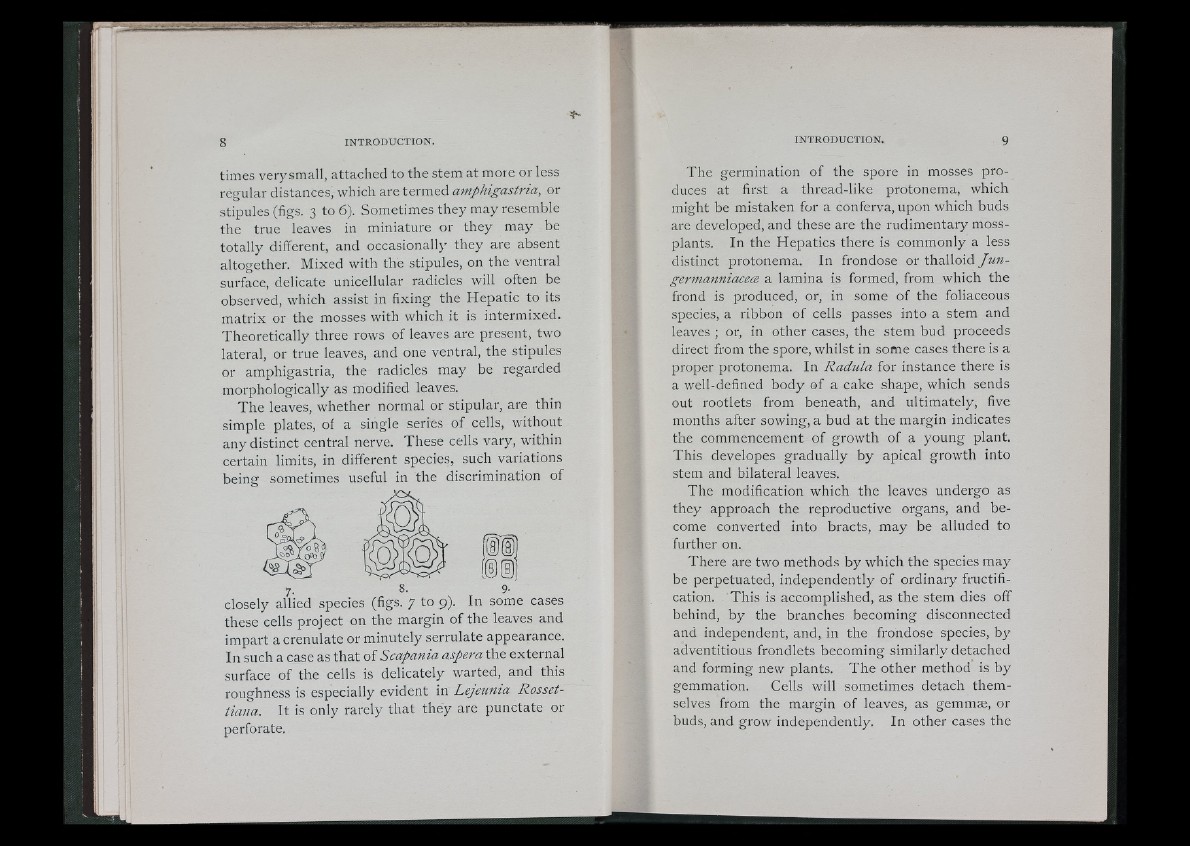
8 INTRODUCTION.
time.s verysmall, attached to the stem at more or less
regular distances, which are termed amphigastria, or
stipules (figs. 3 to 6). Sometimes they may resemble
the true leaves in miniature or they may be
totally different, and occasionally they are absent
altogether. Mixed with the stipules, on the ventral
surface, delicate unicellular radicles will often be
observed, which assist in fixing the Hepatic to its
matrix or the mosses with which it is intermixed.
Theoretically three rows of leaves are present, two
lateral, or true leaves, and one ventral, the stipules
or amphigastria, the radicles may be regarded
morphologically as modified leaves.
The leaves, whether normal or stipular, are thin
simple plates, of a single series of cells, without
any distinct central nerve. These cells vary, within
certain limits, in different species, such variations
being sometimes useful in the discrimination of
7. 8- 9 '
closely allied species (figs. 7 to 9). In some cases
these cells project on the margin of the leaves and
impart acrenulate or minutely serrulate appearance.
In such a case as that of Scapania aspera the external
surface of the cells is delicately warted, and this
roughness is especially evident in Lejeunia Rosset-
tiana. It is only rarely that they are punctate or
perforate.
The germination of the spore in mosses produces
at first a thread-like protonema, which
might be mistaken for a conferva, upon which buds
are developed, and these are the rudimentary moss-
plants. In the Hepatics there is commonly a less
distinct protonema. In frondose or thalloid Ju n germanniacecB
a lamina is formed, from which the
frond is produced, or, in some of the foliaceous
species, a ribbon of cells passes into a stem and
leaves ; or, in other cases, the stem bud proceeds
direct from the spore, whilst in some cases there is a
proper protonema. In Radula for instance there is
a well-defined body of a cake shape, which sends
out rootlets from beneath, and ultimately, five
months after sowing, a bud at the margin indicates
the commencement of growth of a young plant.
This developes gradually by apical growth into
stem and bilateral leaves.
The modification which the leaves undergo as
they approach the reproductive organs, and become
converted into bracts, may be alluded to
further on.
There are two methods by which the species may
be perpetuated, independently of ordinary fructification.
This is accomplished, as the stem dies off
behind, by the branches becoming disconnected
and independent, and, in the frondose species, by
adventitious frondlets becoming similarly detached
and forming new plants. The other method is by
gemmation. Cells will sometimes detach themselves
from the margin of leaves, as gemmae, or
buds, and grow independently. In other cases the